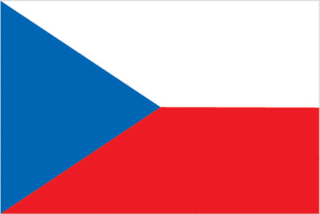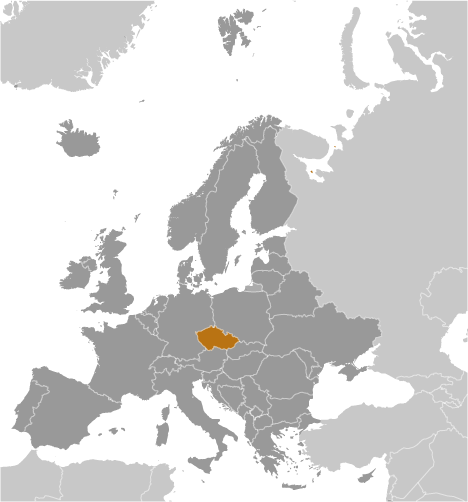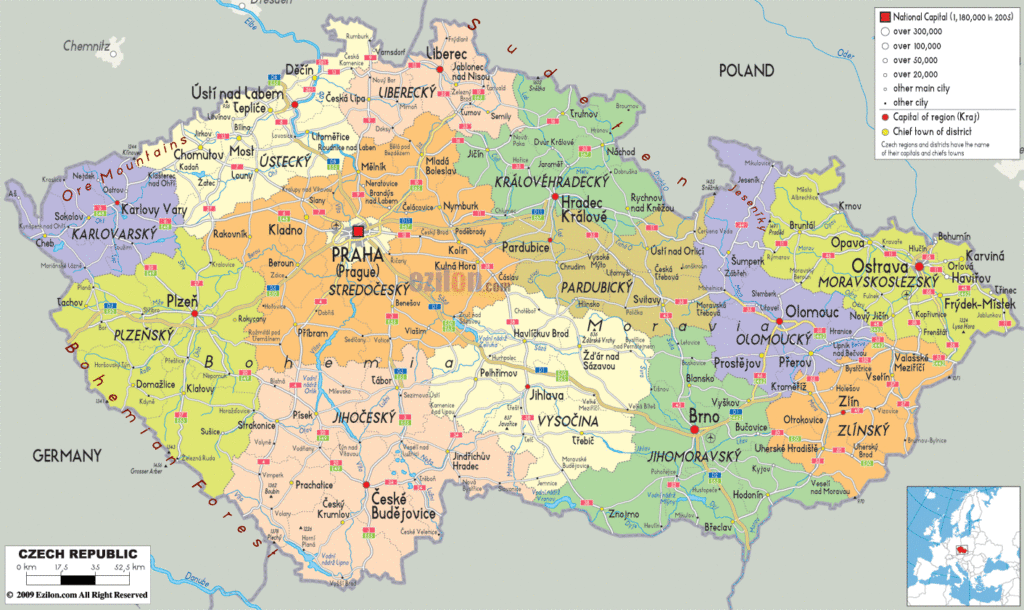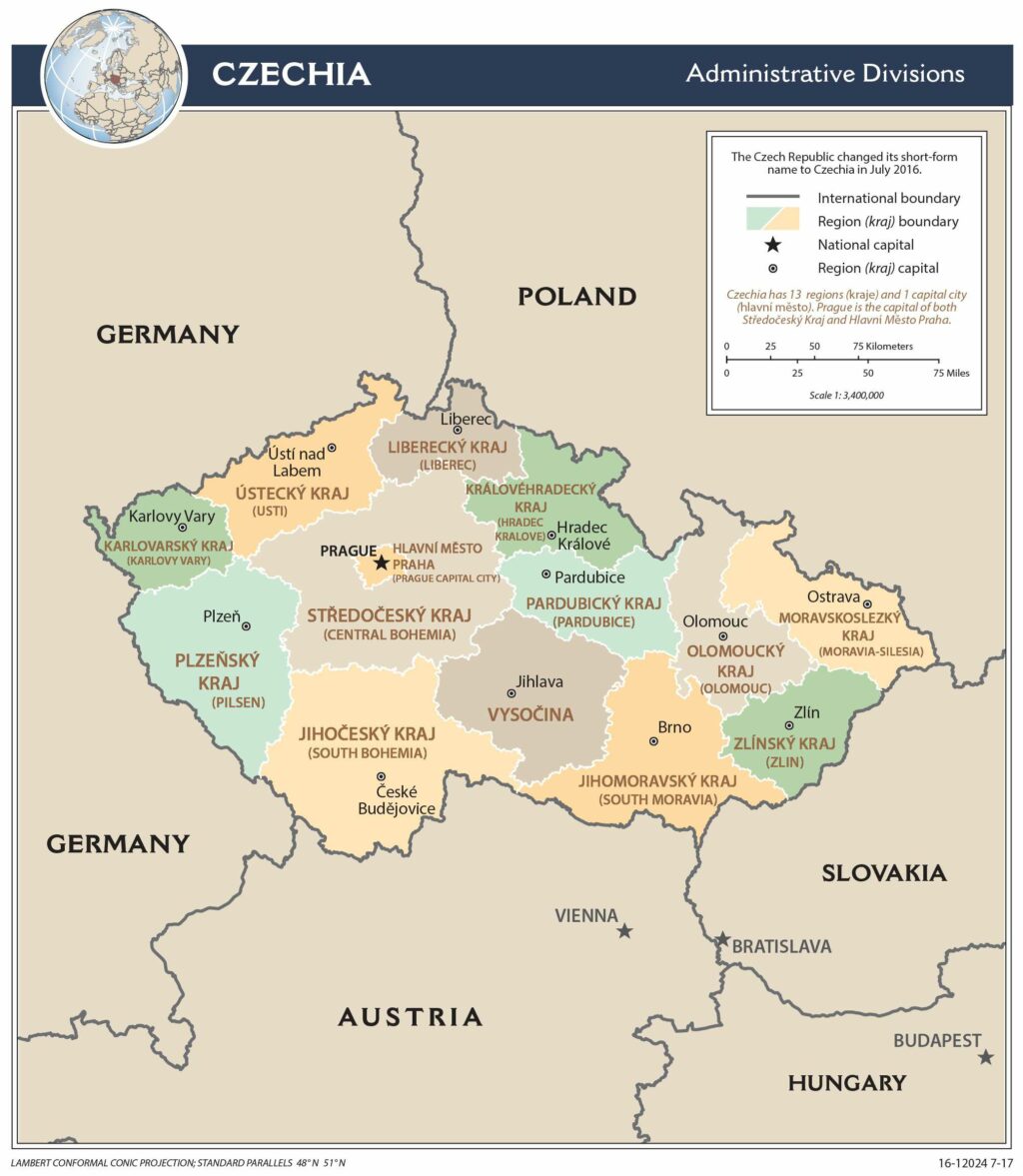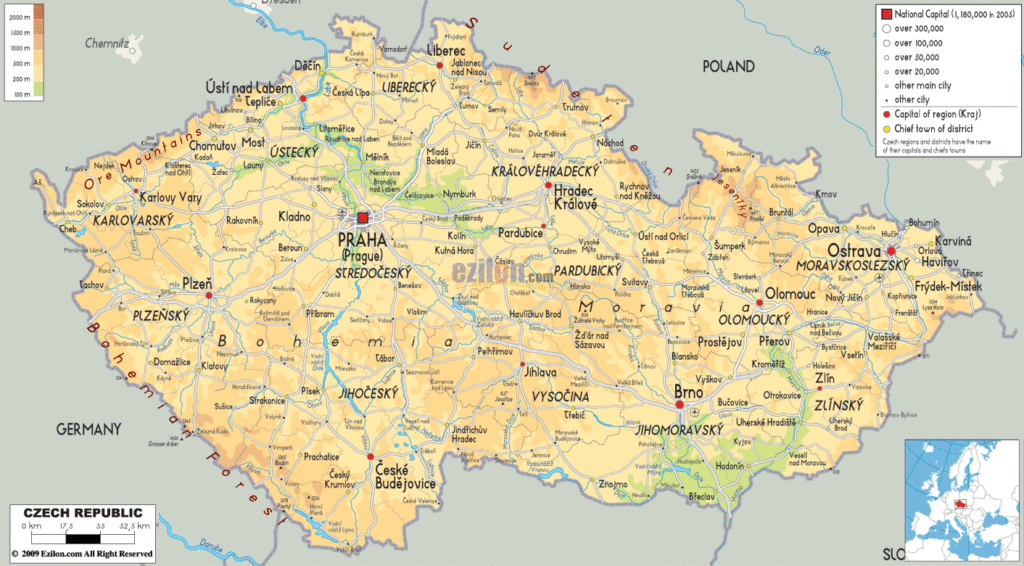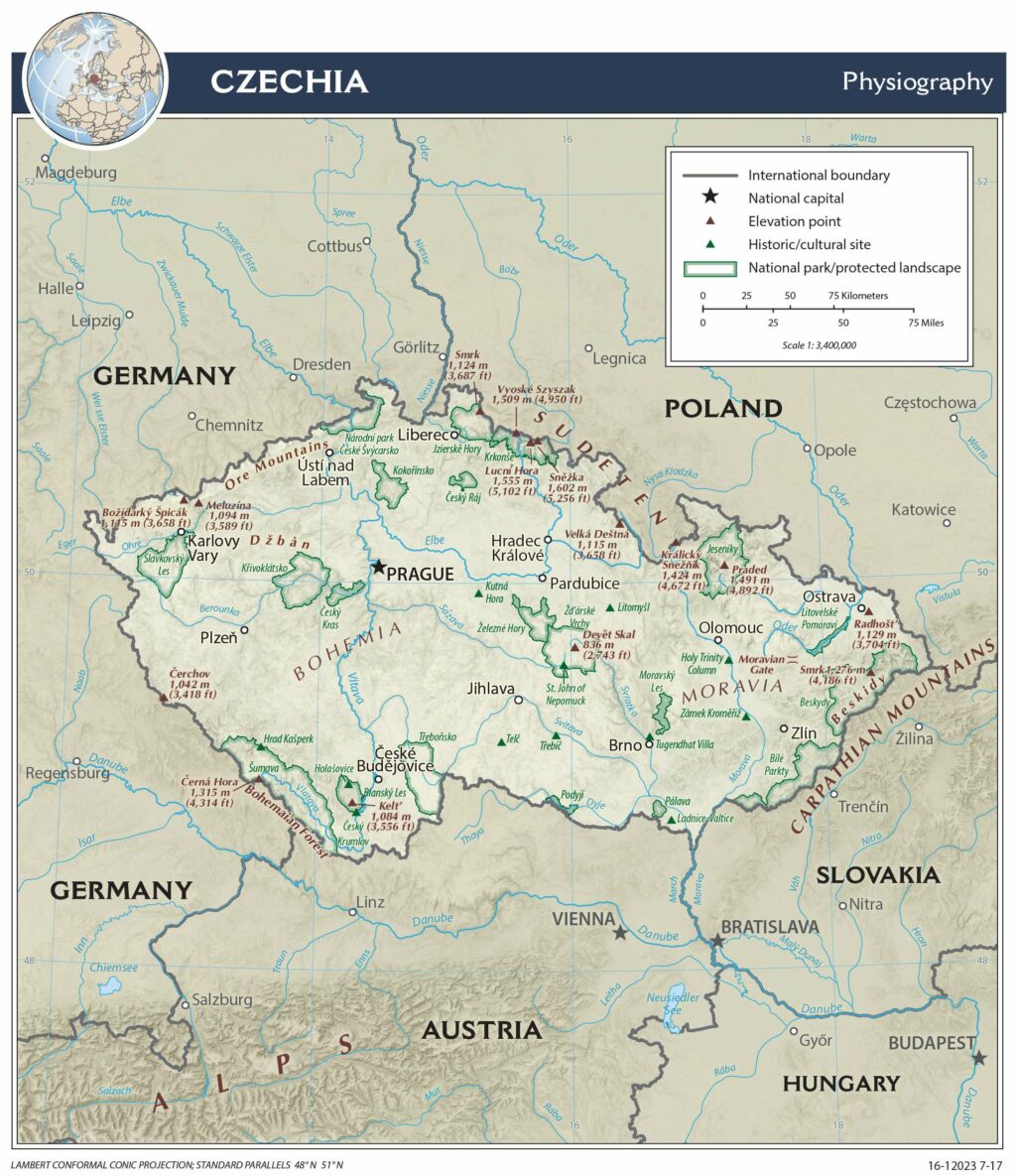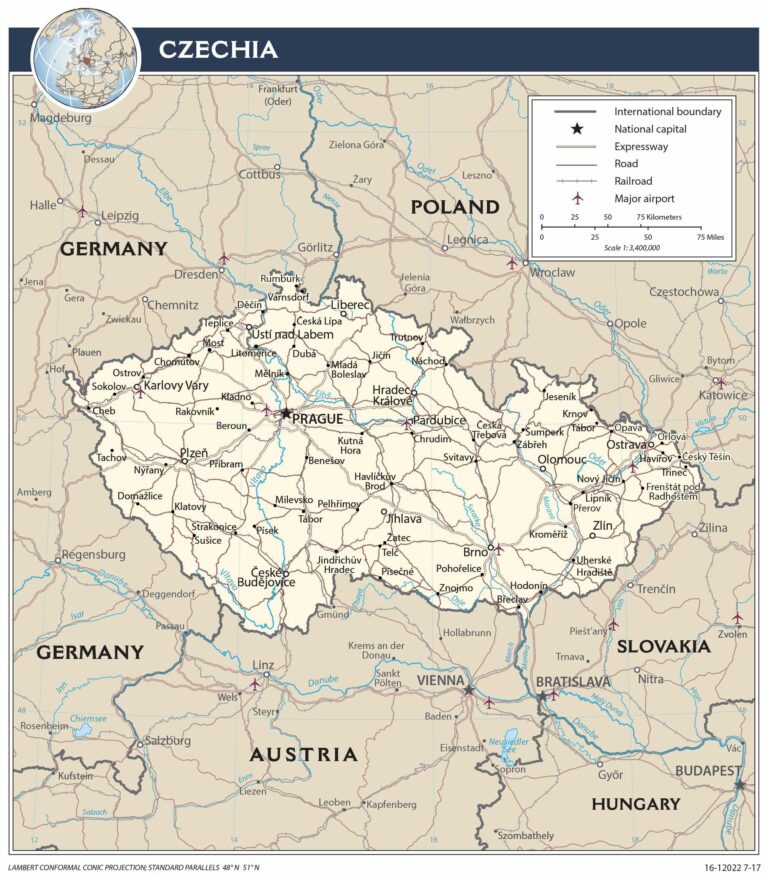The Czech Republic, a landlocked Central European country, covers an area of 78,866 square kilometers (30,450 sq mi).
In general terms, the Czech Republic is a hilly plateau surrounded by relatively low mountains. The bordering mountain ranges can be observed on the physical map of the Czech Republic above. These include the Carpathian, Ore, Sudetic and the Sumarva mountains.
The highest point is Mt. Snezka in the Sudetic Mountains; it rises to 5,259 ft. (1,603 m). The lowest point in the Czech Republic is on the Elba River at 377 ft (115 m). An upright and an inverted yellow triangle marks the position of these extreme points on the map.
Bohemia, mostly occupying the western half of the country, consists of a low-lying basin drained by the Elbe and Vltava rivers. Moravia, covering the eastern part of the country, is hilly land drained mainly by the Morava River
The Oder River, one of Europe’s most significant rivers, rises in the northeast, and flows north to the Baltic Sea.
With a lack of natural lakes, reservoirs are important in the Czech Republic; most are artificial lakes formed in enclosed river valleys and there are over 125 in the country.
Explore the beauty of the Czech Republic with this detailed map. From the bustling cities of Prague and Brno to the winding rivers and highways, this map offers a comprehensive view of the country. The satellite and elevation map allows you to gain a better understanding of the terrain of the Czech Republic. Whether you’re planning a trip or just curious, this Czech Republic map has something for everyone.
Online Interactive Political Map
Click on ![]() to view map in "full screen" mode.
to view map in "full screen" mode.
Czech Republic is divided into 13 regions (kraje, sing. kraj) and 1 capital city (hlavni mesto). The regions are: Central Bohemian, South Bohemian, Vysocina, Plzensky, Karlovy Vary, Usti nad Labem, Liberec, Hradec Kralove, Pardubice, Olomouc, Moravian-Silesian, South Moravian and Zlin. Praha (Prague) is the capital city. The regions are divided into districts and further smaller subdivisions of municipalities.
Located in the center of the Bohemian Basin on the Vltava River is, Prague – the capital, and the largest city of Czech Republic. It is also the 13th largest city of EU and one of the finest cities of the European continent. Prague is the major cultural, industrial and economic center of Czech Republic.
Location Maps
Where is Czech Republic?
The Czech Republic is a landlocked country situated in Central Europe. It is bordered by four European countries, namely Germany to the west, Poland to the northeast, Slovakia to the southeast and Austria to the south. Prague, the capital and largest city of the Czech Republic, is located near the geographical center of the country and was part of Czechoslovakia before it was dissolved in 1993.
The Czech Republic has an area of 78,871 square kilometers (30,452 sq mi), which is similar in size to Austria. The country is divided into three historical regions – Bohemia in the west, Moravia in the east and Czech Silesia in the northeast – which together make up the traditional Czech lands.
High Definition Political Map of Czech Republic
Czech Republic Administrative Map
History
Prehistory
Archaeologists have found evidence of prehistoric human settlements in the area, dating back to the Paleolithic era.
In the classical era, as a result of the 3rd century BC Celtic migrations, Bohemia became associated with the Boii. The Boii founded an oppidum near the site of modern Prague. Later in the 1st century, the Germanic tribes of the Marcomanni and Quadi settled there.
Slavs from the Black Sea–Carpathian region settled in the area (their migration was pushed by an invasion of peoples from Siberia and Eastern Europe into their area: Huns, Avars, Bulgars and Magyars). In the sixth century, the Huns had moved westwards into Bohemia, Moravia, and some of present-day Austria and Germany.
During the 7th century, the Frankish merchant Samo, supporting the Slavs fighting against nearby settled Avars, became the ruler of the first documented Slavic state in Central Europe, Samo’s Empire. The principality of Great Moravia, controlled by Moymir dynasty, arose in the 8th century. It reached its zenith in the 9th (during the reign of Svatopluk I of Moravia), holding off the influence of the Franks. Great Moravia was Christianized, with a role being played by the Byzantine mission of Cyril and Methodius. They codified the Old Church Slavonic language, the first literary and liturgical language of the Slavs, and the Glagolitic alphabet.
Bohemia
The Duchy of Bohemia emerged in the late 9th century when it was unified by the Přemyslid dynasty. Bohemia was from 1002 until 1806 an Imperial State of the Holy Roman Empire.
In 1212, Přemysl Ottokar I extracted the Golden Bull of Sicily from the emperor, confirming Ottokar and his descendants’ royal status; the Duchy of Bohemia was raised to a Kingdom. German immigrants settled in the Bohemian periphery in the 13th century. The Mongols in the invasion of Europe carried their raids into Moravia but were defensively defeated at Olomouc.
After a series of dynastic wars, the House of Luxembourg gained the Bohemian throne.
Efforts for a reform of the church in Bohemia started already in the late 14th century. Jan Hus’s followers seceded from some practices of the Roman Church and in the Hussite Wars (1419–1434) defeated five crusades organized against them by Sigismund. During the next two centuries, 90% of the population in Bohemia and Moravia were considered Hussites. The pacifist thinker Petr Chelčický inspired the movement of the Moravian Brethren (by the middle of the 15th century) that completely separated from the Roman Catholic Church.
On 21 December 1421, Jan Žižka, a successful military commander and mercenary, led his group of forces in the Battle of Kutná Hora, resulting in a victory for the Hussites. He is honoured to this day as a national hero.
After 1526 Bohemia came increasingly under Habsburg control as the Habsburgs became first the elected and then in 1627 the hereditary rulers of Bohemia. Between 1583 and 1611 Prague was the official seat of the Holy Roman Emperor Rudolf II and his court.
The Defenestration of Prague and subsequent revolt against the Habsburgs in 1618 marked the start of the Thirty Years’ War. In 1620, the rebellion in Bohemia was crushed at the Battle of White Mountain and the ties between Bohemia and the Habsburgs’ hereditary lands in Austria were strengthened. The leaders of the Bohemian Revolt were executed in 1621. The nobility and the middle class Protestants had to either convert to Catholicism or leave the country.
The following era of 1620 to the late 18th century became known as the “Dark Age”. During the Thirty Years’ War, the population of the Czech lands declined by a third through the expulsion of Czech Protestants as well as due to the war, disease and famine. The Habsburgs prohibited all Christian confessions other than Catholicism. The flowering of Baroque culture shows the ambiguity of this historical period. Ottoman Turks and Tatars invaded Moravia in 1663. In 1679–1680 the Czech lands faced the Great Plague of Vienna and an uprising of serfs.
There were peasant uprisings influenced by famine. Serfdom was abolished between 1781 and 1848. Several battles of the Napoleonic Wars took place on the current territory of the Czech Republic.
The end of the Holy Roman Empire in 1806 led to degradation of the political status of Bohemia which lost its position of an electorate of the Holy Roman Empire as well as its own political representation in the Imperial Diet. Bohemian lands became part of the Austrian Empire. During the 18th and 19th century the Czech National Revival began its rise, with the purpose to revive Czech language, culture, and national identity. The Revolution of 1848 in Prague, striving for liberal reforms and autonomy of the Bohemian Crown within the Austrian Empire, was suppressed.
It seemed that some concessions would be made also to Bohemia, but in the end, the Emperor Franz Joseph I affected a compromise with Hungary only. The Austro-Hungarian Compromise of 1867 and the never realized coronation of Franz Joseph as King of Bohemia led to a disappointment of some Czech politicians. The Bohemian Crown lands became part of the so-called Cisleithania.
The Czech Social Democratic and progressive politicians started the fight for universal suffrage. The first elections under universal male suffrage were held in 1907.
Czechoslovakia
In 1918, during the collapse of the Habsburg monarchy at the end of World War I, the independent republic of Czechoslovakia, which joined the winning Allied powers, was created, with Tomáš Garrigue Masaryk in the lead. This new country incorporated the Bohemian Crown.
The First Czechoslovak Republic comprised only 27% of the population of the former Austria-Hungary, but nearly 80% of the industry, which enabled it to compete with Western industrial states. In 1929 compared to 1913, the gross domestic product increased by 52% and industrial production by 41%. In 1938 Czechoslovakia held 10th place in the world industrial production. Czechoslovakia was the only country in Central and Eastern Europe to remain a liberal democracy throughout the entire interwar period. Although the First Czechoslovak Republic was a unitary state, it provided certain rights to its minorities, the largest being Germans (23.6% in 1921), Hungarians (5.6%) and Ukrainians (3.5%).
Western Czechoslovakia was occupied by Nazi Germany, which placed most of the region into the Protectorate of Bohemia and Moravia. The Protectorate was proclaimed part of the Third Reich, and the president and prime minister were subordinated to Nazi Germany’s Reichsprotektor. One Nazi concentration camp was located within the Czech territory at Terezín, north of Prague. The vast majority of the Protectorate’s Jews were murdered in Nazi-run concentration camps. The Nazi Generalplan Ost called for the extermination, expulsion, Germanization or enslavement of most or all Czechs for the purpose of providing more living space for the German people. There was Czechoslovak resistance to Nazi occupation as well as reprisals against the Czechoslovaks for their anti-Nazi resistance. The German occupation ended on 9 May 1945, with the arrival of the Soviet and American armies and the Prague uprising. Most of Czechoslovakia’s German-speakers were forcibly expelled from the country, first as a result of local acts of violence and then under the aegis of an “organized transfer” confirmed by the Soviet Union, the United States, and Great Britain at the Potsdam Conference.
In the 1946 elections, the Communist Party gained 38% of the votes and became the largest party in the Czechoslovak parliament, formed a coalition with other parties, and consolidated power. A coup d’état came in 1948 and a single-party government was formed. For the next 41 years, the Czechoslovak Communist state conformed to Eastern Bloc economic and political features. The Prague Spring political liberalization was stopped by the 1968 Warsaw Pact invasion of Czechoslovakia. Analysts believe that the invasion caused the communist movement to fracture, ultimately leading to the Revolutions of 1989.
Czech Republic
In November 1989, Czechoslovakia again became a liberal democracy through the Velvet Revolution. However, Slovak national aspirations strengthened (Hyphen War) and on 31 December 1992, the country peacefully split into the independent countries of the Czech Republic and Slovakia. Both countries went through economic reforms and privatizations, with the intention of creating a market economy, as they have been trying to do since 1990, when Czechs and Slovaks still shared the common state. This process was largely successful; in 2006 the Czech Republic was recognized by the World Bank as a “developed country”, and in 2009 the Human Development Index ranked it as a nation of “Very High Human Development”.
From 1991, the Czech Republic, originally as part of Czechoslovakia and since 1993 in its own right, has been a member of the Visegrád Group and from 1995, the OECD. The Czech Republic joined NATO on 12 March 1999 and the European Union on 1 May 2004. On 21 December 2007 the Czech Republic joined the Schengen Area.
Until 2017, either the centre-left Czech Social Democratic Party or the centre-right Civic Democratic Party led the governments of the Czech Republic. In October 2017, the populist movement ANO 2011, led by the country’s second-richest man, Andrej Babiš, won the elections with three times more votes than its closest rival, the Civic Democrats. In December 2017, Czech president Miloš Zeman appointed Andrej Babiš as the new prime minister.
In the 2021 elections, ANO 2011 was narrowly defeated and Petr Fiala became the new prime minister. He formed a government coalition of the alliance SPOLU (Civic Democratic Party, KDU-ČSL and TOP 09) and the alliance of Pirates and Mayors. In January 2023, retired general Petr Pavel won the presidential election, becoming new Czech president to succeed Miloš Zeman. Following the 2022 Russian invasion of Ukraine, the country took in half a million Ukrainian refugees, the largest number per capita in the world.
Physical Map of Czech Republic

